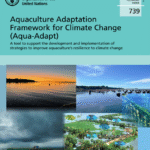By Susanne Liljenström*
Pacific oyster farming is a multi-billion dollar industry, but there are strong concerns about the ability of oyster larvae to develop properly and survive in future ocean acidification scenarios. A recent study from University of Gothenburg shows that long-term breeding might reduce the genetic response to experimental ocean acidification in oyster larvae. The capacity to adapt to future environments could thus be impaired.
For sessile species like oysters that cannot migrate to favourable habitats, long-term survival in changing environments will likely have to rely on genetic adaptation. However, the adaptive capacity is fundamentally based on genetic diversity from which new combinations of traits can arise. Understanding evolutionary processes is therefore a critical component in understanding the responses of species and ecosystems to climate and other environmental change.
Researcher Pierre De Wit and colleagues investigated what is happening genetically as oyster larvae develop from fertilized eggs to settlement-ready larvae and go through natural selection due to carbon dioxide increase. Genetic changes were evaluated during development of larvae reared in ambient (~400 µatm) and in high (~1600 µatm) pCO2conditions, both in domesticated and in “wild” oysters from the Pacific Northwest, USA.
Surprisingly complex genetic response
“We found that oysters that have been bred in hatchery conditions for multiple generations show less genetic changes to experimental ocean acidification treatments than wild-caught oysters. This indicates that they could have lost some of the capability to adapt to high CO2, possibly due to a loss of genetic diversity during breeding”, says Pierre De Wit.
A related study revealed surprising patterns of genetic change during the larval development. A relatively large proportion of the genetic material seemed to be under different selective pressure at different timepoints during development. This indicates it could be beneficial to have one version of some genes at one larval stage, but another version of those same genes during the next stage. A conclusion is that heterozygote individuals, who have both versions of a gene, are favoured on average.
“This shows that natural selection processes are very complex and dynamic in larval stages of oysters. Thus, preserving the genetic diversity of the broodstock in oyster hatcheries could be an important tool for maintaining resilience in the production,” concludes Pierre De Wit.
Contact
Pierre de Wit
Researcher
+46 766-22 95 50
+46 31-786 95 50
pierre.de_wit@marine.gu.se
Stay Always Informed
Join our communities to instantly receive the most important news, reports, and analysis from the aquaculture industry.
Reference (open access):
Evan Durland, Pierre De Wit, Eli Meyer, Chris Langdon. Larval development in the Pacific oyster and the impacts of ocean acidification: Differential genetic effects in wild and domesticated stocks. Published in Evolutionary Applications, August 2021.
Evan Durland, Pierre De Wit and Chris Langdon. Temporally balanced selection during development of larval Pacific oysters (Crassostrea gigas) inherently preserves genetic diversity within offspring. Published in Proceedings of the Royal Society of London, September 2021.
*Source: University of Gothenburg
Editor at the digital magazine AquaHoy. He holds a degree in Aquaculture Biology from the National University of Santa (UNS) and a Master’s degree in Science and Innovation Management from the Polytechnic University of Valencia, with postgraduate diplomas in Business Innovation and Innovation Management. He possesses extensive experience in the aquaculture and fisheries sector, having led the Fisheries Innovation Unit of the National Program for Innovation in Fisheries and Aquaculture (PNIPA). He has served as a senior consultant in technology watch, an innovation project formulator and advisor, and a lecturer at UNS. He is a member of the Peruvian College of Biologists and was recognized by the World Aquaculture Society (WAS) in 2016 for his contribution to aquaculture.




